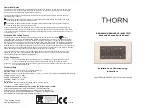
configuration. A subset of these options are the FIPS-approved algorithms: HMAC-SHA1-96 for
authentication and AES128-CFB for privacy. The other options are not FIPS-approved algorithms because
of known security weaknesses. The AES128-CFB privacy option is supported and is compliant with RFC
3826.
The SNMPv3 feature also uses a FIPS-validated cryptographic module for all of its cryptographic
operations when the system is configured with the
fips mode enable
command in Global
Configuration mode. When the FIPS mode is enabled on the system, SNMPv3 operates in a FIPS-
compliant manner, and only the FIPS-approved algorithm options are available for SNMPv3 user
configuration. When the FIPS mode is disabled on the system, all options are available for SNMPv3 user
configuration.
The following table describes the authentication and privacy options that can be configured when the
FIPS mode is enabled or disabled:
FIPS Mode
Privacy Options
Authentication Options
Disabled
des56 (DES56-CBC)
aes128 (AES128-CFB)
md5 (HMAC-MD5-96)
sha (HMAC-SHA1-96)
Enabled
aes128 (AES128-CFB)
sha (HMAC-SHA1-96)
To enable security for SNMP packets transferred between the server and the client, you can use the
snmp-server user
username
group
groupname
3 auth
authentication-type auth-
password
priv aes128
priv-password
command to specify that AES-CFB 128 encryption
algorithm needs to be used.
Dell(conf)#snmp-server user snmpguy snmpmon 3 auth sha AArt61wq priv aes128
jntRR59a
In this example, for a specified user and a group, the AES128-CFB algorithm, the authentication password
to enable the server to receive packets from the host, and the privacy password to encode the message
contents are configured.
SHA authentication needs to be used with the AES-CFB128 privacy algorithm only when FIPS is enabled
because SHA is then the only available authentication level. If FIPS is disabled, you can use MD5
authentication in addition to SHA authentication with the AES-CFB128 privacy algorithm
You cannot modify the FIPS mode if SNMPv3 users are already configured and present in the system. An
error message is displayed if you attempt to change the FIPS mode by using the
fips mode enable
command in Global Configuration mode. You can enable or disable FIPS mode only if SNMPv3 users are
not previously set up. If previously configured users exist on the system, you must delete the existing
users before you change the FIPS mode.
Keep the following points in mind when you configure the AES128-CFB algorithm for SNMPv3:
1.
SNMPv3 authentication provides only the
sha
option when the FIPS mode is enabled.
2.
SNMPv3 privacy provides only the
aes128 privacy
option when the FIPS mode is enabled.
3.
If you attempt to enable or disable FIPS mode and if any SNMPv3 users are previously configured, an
error message is displayed stating you must delete all of the SNMP users before changing the FIPS
mode.
926
Simple Network Management Protocol (SNMP)
Summary of Contents for S4820T
Page 1: ...Dell Configuration Guide for the S4820T System 9 8 0 0 ...
Page 282: ...Dell 282 Control Plane Policing CoPP ...
Page 622: ...Figure 81 Configuring Interfaces for MSDP 622 Multicast Source Discovery Protocol MSDP ...
Page 623: ...Figure 82 Configuring OSPF and BGP for MSDP Multicast Source Discovery Protocol MSDP 623 ...
Page 629: ...Figure 86 MSDP Default Peer Scenario 2 Multicast Source Discovery Protocol MSDP 629 ...
Page 630: ...Figure 87 MSDP Default Peer Scenario 3 630 Multicast Source Discovery Protocol MSDP ...
Page 751: ...10 11 5 2 00 00 05 00 02 04 Member Ports Te 1 2 1 PIM Source Specific Mode PIM SSM 751 ...
Page 905: ...Figure 112 Single and Double Tag First byte TPID Match Service Provider Bridging 905 ...
Page 979: ...6 Member not present 7 Member not present Stacking 979 ...
Page 981: ...storm control Storm Control 981 ...
Page 1103: ...Figure 134 Setup OSPF and Static Routes Virtual Routing and Forwarding VRF 1103 ...
















































